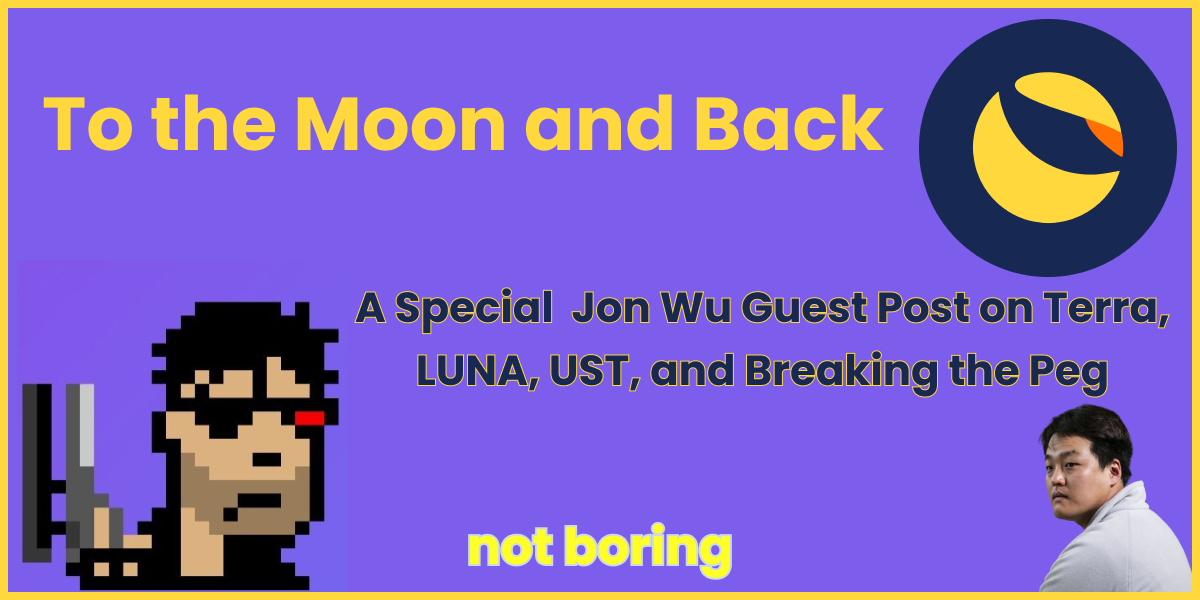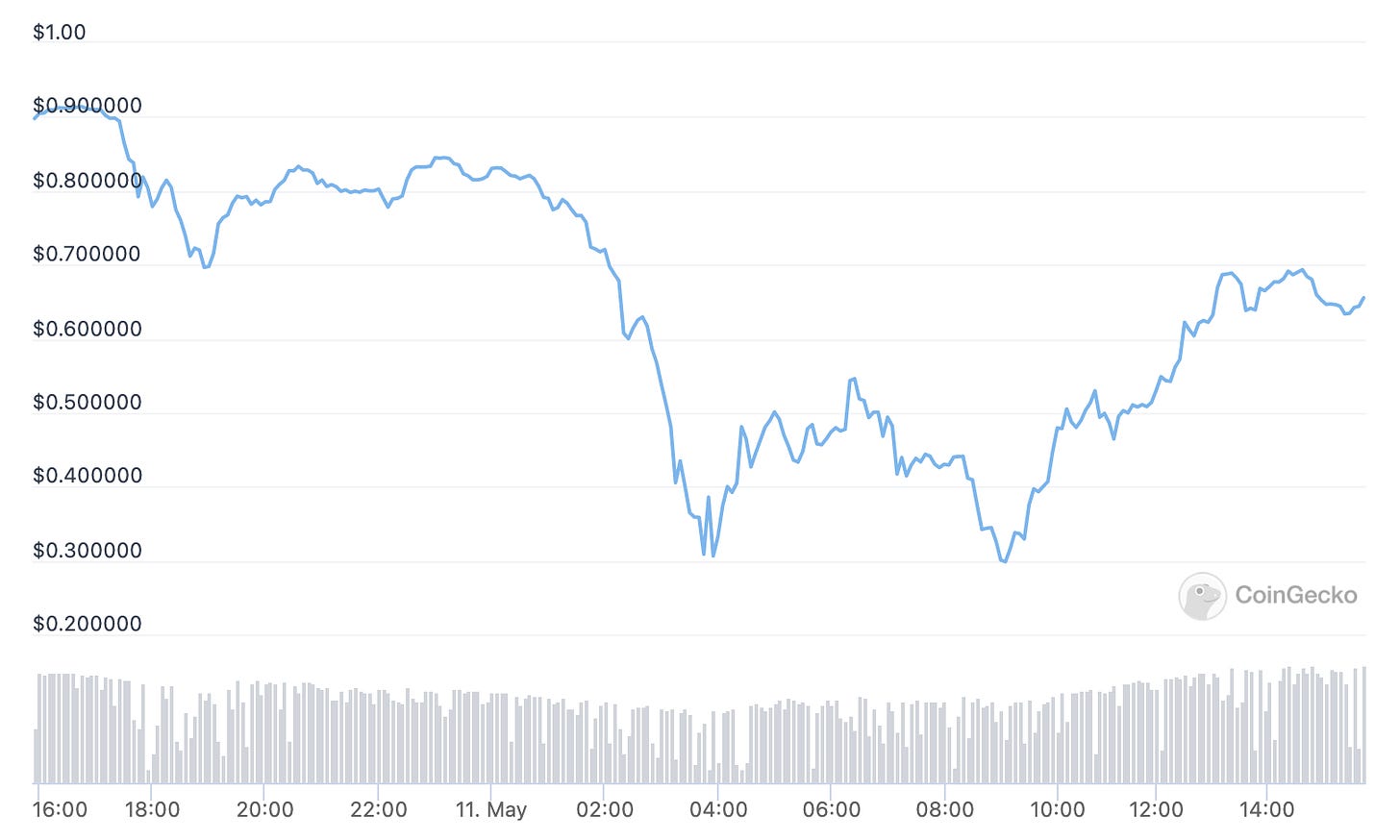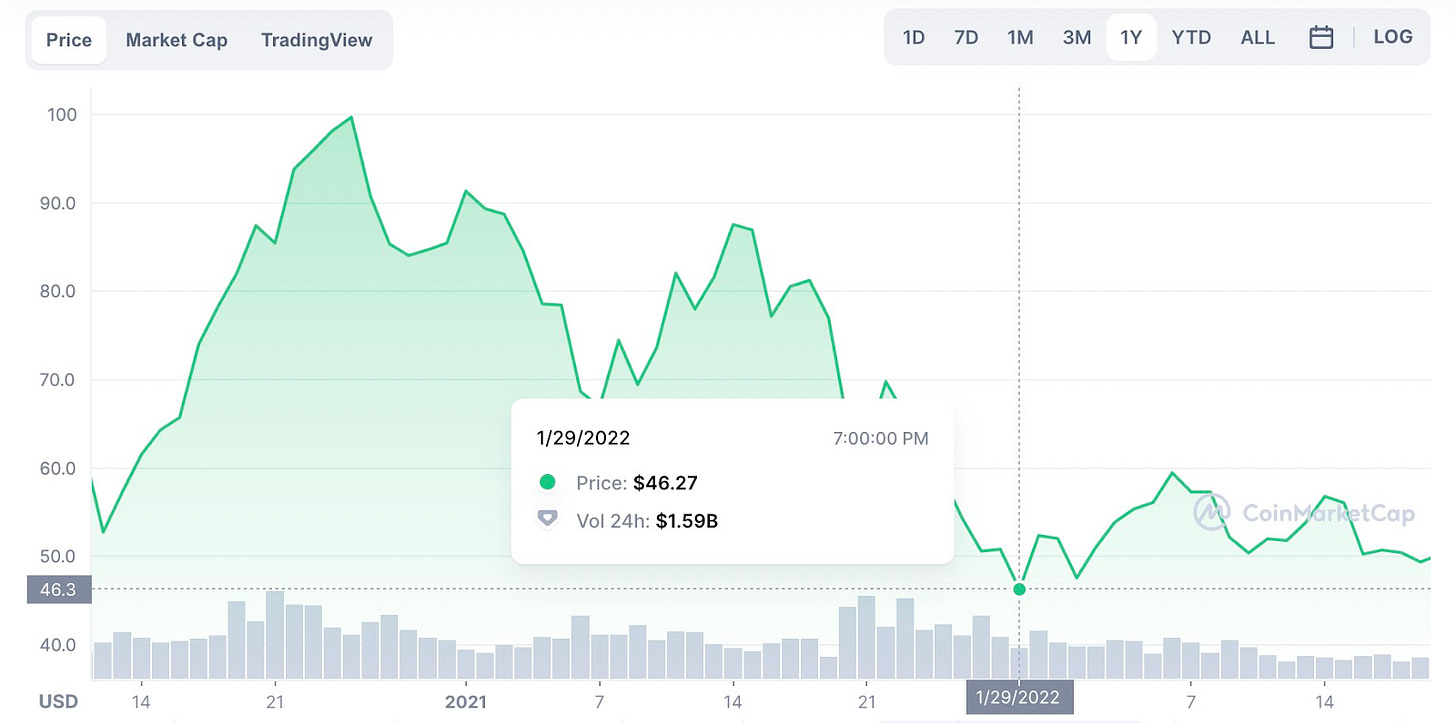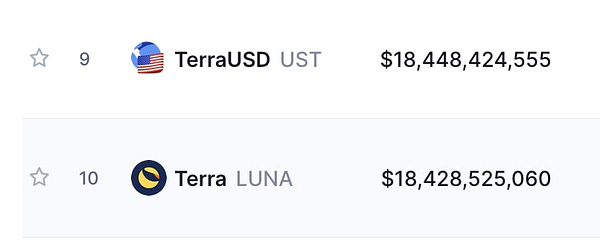Not Boring by Packy McCormick - Terra: To the Moon and Back
Welcome to the 1,281 newly Not Boring people who have joined us since Monday! If you haven’t subscribed, join 122,025 smart, curious folks by subscribing here: Today’s Not Boring is brought to you by… FTX US If you’ve been following crypto at all over the past year, or if you listen to Not Boring Founders, you know FTX US and its founder, Sam Bankman-Fried (SBF). Simply put, FTX US is one of the most complete apps in crypto, and its trading platform has the lowest fees in the industry. With FTX US, you can trade crypto with up to 85% lower fees than any other exchange on the market. Of course, you can buy cryptocurrencies like BTC, ETH, and SOL (don’t look now, but they’re a lot cheaper than they were a week ago), but you can also buy Ethereum and Solana NFTs with no gas fees, and soon, you’ll be able to buy stocks on FTX US. To get started on a safe, accessible investing platform, download the FTX US app on your phone or, for a more advanced experience, try the newly redesigned FTX US web app. Make sure to use the code NOTBORING to get free crypto when you trade over $10. Hi friends 👋, Happy Thursday! We weren’t planning on sending anything out today, but then the market completely crumbled. It’s been a bloody, across-the-board meltdown kind of week, but one meltdown in particular has captured everyone’s attention: Terra. Specifically, Terra’s two native tokens, Luna (LUNA) and TerraUSD (UST) were supposed to work in tandem to peg UST, the algorithmic stablecoin, to a $1 price. It’s important that stablecoins are worth $1, because their whole point is to be worth $1. When everything fluctuates wildly, people need something they can use to reliably spend and transact. The world’s two biggest stablecoins — USDC and USDT — are both backed by relatively stable assets like dollars and bonds, that sit in a bank account, $1 worth for every $1 worth of stablecoin. That’s the safer way to do it (although whether Tether (USDT) is actually 100% doing it has been the subject of debate). Algorithmic stablecoins, which are deeply undercollateralized, are a much riskier proposition, and many attempts at pulling it off have failed. It’s just that none have gotten as big as UST, thanks to its charismatic founder Do Kwon, whose twitter handle is literally @stablekwon, and the ecosystem that Terra has built on top of its L1. The fact that UST broke its peg to the dollar, and that LUNA is down from an all-time high of $119 to its current price of $0.09 is a big, big deal. It’s broken an already shaky market. And if you’re at all interested in crypto, you should understand what happened. So I’m bringing in my friend Jon Wu, who has become of the the most popular follows on Crypto Twitter for, among other things, his simple and colorful explanations of really complex things happening in DeFi. As I was getting up to speed, I leaned heavily on Jon’s expertise, like I did for Who Disrupts the Disruptors? When he’s not tweeting or making me smarter, Jon runs growth at Aztec, a privacy-first crypto network bringing cheap, private transactions to Ethereum. As this situation unfolded, Jon dropped the best explainer thread on the situation. It’s now over 21.7k likes. I asked him to share an updated version here on Not Boring to bring us up to speed. The situation is ongoing, so follow Jon to stay up on it. Let’s get to it. To the Moon and BackAn $18 billion stablecoin is losing its dollar peg with all the magical chaos of algorithmic stables, with a dash of Bitcoin systemic risk drama. Here's everything you need to know. $UST is a dollar-pegged stablecoin that depegged over the weekend and again on Monday, vacillating wildly but consistently below its $1.00. As of this writing it sits at around $0.50. A reminder on how $UST works: You can always redeem $LUNA for $UST dollar-for-dollar, and vice versa. If $LUNA is at $50, you can redeem it for 50 $UST. Similarly, you can redeem 50 $UST for 1 $LUNA. It's worth noting you can always redeem 1 $UST for 1 dollar worth of $LUNA, even if $UST is worth <$1. This part is confusing, but in English: “We promise to give you a dollar’s worth of something if you give us 1 $UST.” (that something, of course, being $LUNA). It's meant to be a stabilizing mechanism: If $UST is trading at $0.99, arbitrageurs can buy it and redeem it for $1 of $LUNA, pocketing $0.01. This is called the contraction phase, because demand for $UST is falling. Of course when $UST is trading at $1.01, arbitrageurs can do the inverse–trade $1 of $LUNA for 1 $UST, and pocket $0.01. This is called the expansion phase, because demand for $UST is expanding. Note that another form of arbitrage also exists–simply selling 1 $UST for $1.01 of $USDC. If you’re holding a dollar bill and someone says they’ll give you a dollar and a penny for it, you should probably, uh, sell it. But of course curtailing expansion is easier than fixing contraction. Why? When expansion (“too much demand”) occurs, $LUNA is burned for $UST, reducing $LUNA supply. Assuming $LUNA demand stays fixed, $LUNA’s price goes up. Something something economics 101. It’s the downside that’s important to protect, and the way to do that is giving people a reason to hold $UST, or some kind of utility. Stablecoins Require Utility™ to maintain demand and defend their peg. So where does $UST get utility? Simple, Anchor Protocol. Anchor Protocol is (nominally) a money market, but the important tl;dr is it pays you 19.5% to stake $UST. You can think of Anchor as a high-yield savings account. After all, putting your money in a savings account is one way in which the US dollar is useful. Of course it’s useful for many, many other things like buying groceries, paying taxes, and making origami swans. A huge proportion of $UST's circulating supply has historically been in Anchor. Now of course, depositors are withdrawing at a rapid clip. As of a few days ago, Anchor had 14 billion+ UST in deposits, down now to around 3.3 billion UST (worth about $2 billion). So again: why hold $UST? Easy: because Anchor’s paying you 20% per year to hold it. Two obvious questions: 1) if something is paying you 20% risk-free*, why not just borrow a ton of money and make it pay you like, 100%+? Oh uhm, that's exactly what Abracadabra / $MIM's degenbox did, a recursive borrow strategy that allowed people to borrow with 5x net leverage:  Degenbox and the rest of the Frog Nation DeFi ecosystem unwound in January, depegging $UST and sending $LUNA from $100 down to $46. Sound kinda familiar? Something something history may not repeat itself but it can rhyme. 2) How does one give out 20% in free money every year? Well that's also easy, it’s paid for by LFG (Luna Foundation Guard), overseers of Terra's multi-billion dollar ecosystem fund. We'll come back to them. First we need to figure out what the $LUNA token does: I'm not going to focus on what drives its fundamental value and focus instead narrative: ~Every $UST in circulation reduces the circulation of $LUNA~ The win scenario is every single $LUNA on earth gets burned for $UST. You can see the basic appeal: The more $UST, the less $LUNA. Holders should want to diamond-hands $LUNA: If there's unstoppable demand for $UST and you're the last $LUNA holder on earth, you have immense redemption power. It's right on their YouTube video:  That's kind of why it doesn’t matter much whether $LUNA marketcap is lower than $UST marketcap. It doesn't matter what the total implied value of $LUNA is. What matters is the marginal value of each $LUNA that is redeemed for $UST, or vice versa, aka $LUNA's price. But what's even MORE important is the directionality and stability of $LUNA's price. It's a Big Motherfucking Problem if the average redemption price of $LUNA for $UST is high relative to $LUNA's current price. Let me slow that one down:
That is bad mmkay? Allow me to illustrate using extremes. Say the price of $LUNA is $1 billion. Then someone could mint 1 billion $UST by burning a single $LUNA. Then let's say the price of $LUNA falls to $1 for no good reason. That same person could redeem their 1 billion UST for 1 billion $LUNA. So suddenly--again, for no good reason at all--there's a LOT more $LUNA in circulation being dumped on the open market. This is--in essence--what's happening today. So now back to the Luna Foundation Guard: $UST has the same dynamics as many other algo-stables, except in addition to the "algo" part they also have LFG. In other words, UST is stabilized by: 1) Contracts. 2) The gigantic gravity well created by the size of Do Kwon's nuts. Previously the LFG was in charge of the Anchor bootstrapping strategy: Take treasury $LUNA, sell it, and fill up the Anchor Protocol Reserve (the big slush fund that pays $UST stakers 20%). Every other L1 eco fund uses similar give-money-away-to-boostrap-the-ecosystem type strategies, just less directly. What’s the bet behind funding Anchor? IsN’t iT a PonZi?! Well, paying people to lock up $UST means that in the short-term:
And, longer term:
Hence this tweet where Do Kwon confidently polls the audience before adding $300 million to Anchor’s reserves: Relative to Luna’s marketcap, $300 million was nothing at the time! Then in January, Abracadabra-MIM Degenbox collapsed. That implosion took down a big push for $UST to be used in a 10-figure cross-chain ecosystem headed by Daniele Sesta. That's when Jump, 3AC, and others piled into the $1 billion Luna OTC deal to buy Bitcoin. To be explicit, that meant LFG would sell $1 billion of Luna to market makers and use the proceeds to buy Bitcoin to use as collateral against $UST. The story there? 1) Get the Bitcoin gang on board (every cycle needs one billionaire to go hard for the King) 2) Give redemptions a $UST -> $BTC offramp in addition to the existing $UST -> $LUNA one, giving folks a way to redeem $UST without accessing the Death Spiral. To read about the Death Spiral, What’s Happening Now, and the tl;dr Summary: If you don’t already, you need to follow Jon on Twitter to keep up to date with crypto. Good luck out there. It helps to zoom out. I’m reading Carlo Rovelli’s There Are Places In The World Where Rules Are Less Important Than Kindness, and it’s wonderful. Thanks for reading, and see you on Monday, Packy If you liked this post from Not Boring by Packy McCormick, why not share it? |
Older messages
If We Ruled the Tweets
Monday, May 9, 2022
Twitter's Power Users, the WeChat Opportunity, and TweeterDAO
Three Not Boring Things
Thursday, May 5, 2022
Reader Survey, Talent Collective, Founders Podcast
Tokengated Commerce
Monday, May 2, 2022
Alex Danco Joins to Explain NFTs and How Shopify is Becoming Wallet-Aware
Primer: The Ambitious Home for Ambitious Kids
Thursday, April 28, 2022
Announcing a $15M Series A, Microschools, and Expert-Led Clubs
Celo: Building a Regenerative Economy
Monday, April 25, 2022
The Carbon-Negative Blockchain Making Money Beautiful
You Might Also Like
🔮 $320B investments by Meta, Amazon, & Google!
Friday, February 14, 2025
🧠 AI is exploding already!
✍🏼 Why founders are using Playbookz
Friday, February 14, 2025
Busy founders are using Playbookz build ultra profitable personal brands
Is AI going to help or hurt your SEO?
Friday, February 14, 2025
Everyone is talking about how AI is changing SEO, but what you should be asking is how you can change your SEO game with AI. Join me and my team on Tuesday, February 18, for a live webinar where we
Our marketing playbook revealed
Friday, February 14, 2025
Today's Guide to the Marketing Jungle from Social Media Examiner... Presented by social-media-marketing-world-logo It's National Cribbage Day, Reader... Don't get skunked! In today's
Connect one-on-one with programmatic marketing leaders
Friday, February 14, 2025
Enhanced networking at Digiday events
Outsmart Your SaaS Competitors with These SEO Strategies 🚀
Friday, February 14, 2025
SEO Tip #76
Temu and Shein's Dominance Is Over [Roundup]
Friday, February 14, 2025
Hey Reader, Is the removal of the de minimis threshold a win for e-commerce sellers? With Chinese marketplaces like Shein and Temu taking advantage of this threshold, does the removal mean consumers
"Agencies are dying."
Friday, February 14, 2025
What this means for your agency and how to navigate the shift ͏ ͏ ͏ ͏ ͏ ͏ ͏ ͏ ͏ ͏ ͏ ͏ ͏ ͏ ͏ ͏ ͏ ͏ ͏ ͏ ͏ ͏ ͏ ͏ ͏ ͏ ͏ ͏ ͏ ͏ ͏ ͏ ͏ ͏ ͏ ͏ ͏ ͏ ͏ ͏ ͏ ͏ ͏ ͏ ͏ ͏
Is GEO replacing SEO?
Friday, February 14, 2025
Generative Engine Optimization (GEO) is here, and Search Engine Optimization (SEO) is under threat. But what is GEO? What does it involve? And what is in store for businesses that rely on SEO to drive
🌁#87: Why DeepResearch Should Be Your New Hire
Friday, February 14, 2025
– this new agent from OpenAI is mind blowing and – I can't believe I say that – worth $200/month









